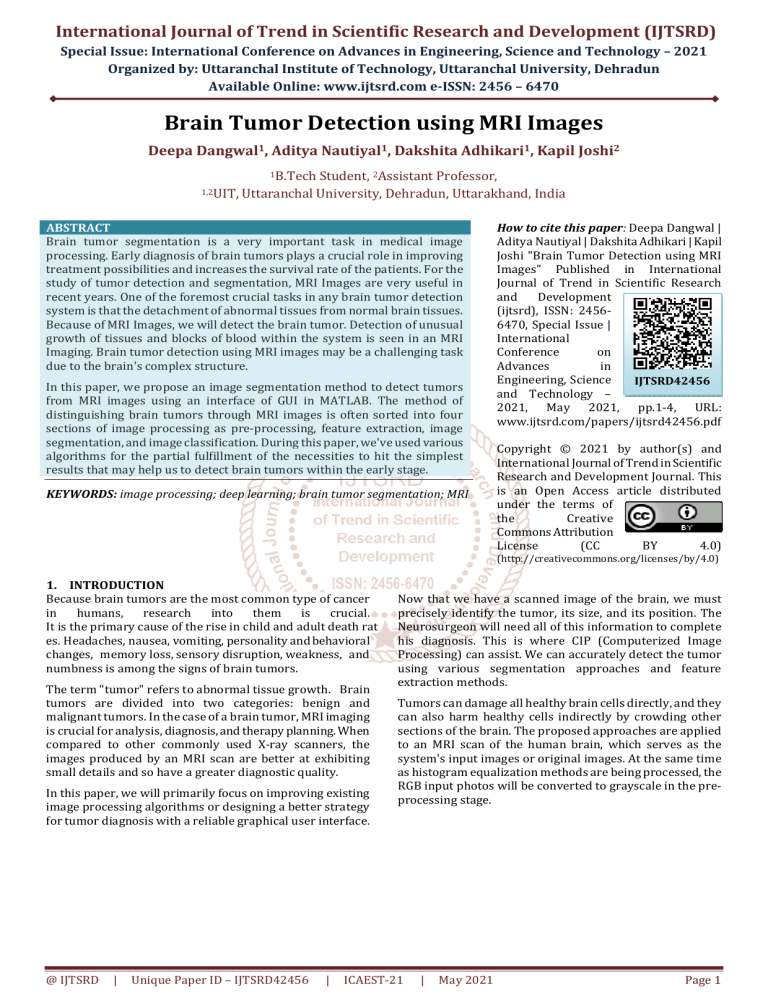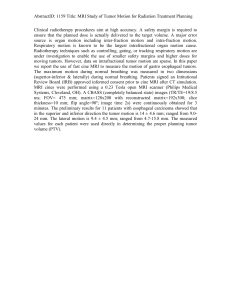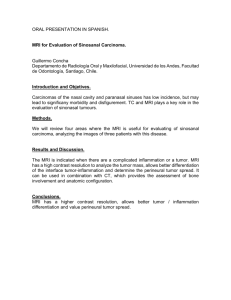
International Journal of Trend in Scientific Research and Development (IJTSRD) Special Issue: International Conference on Advances in Engineering, Science and Technology – 2021 Organized by: Uttaranchal Institute of Technology, Uttaranchal University, Dehradun Available Online: www.ijtsrd.com e-ISSN: 2456 – 6470 Brain Tumor Detection using MRI Images Deepa Dangwal1, Aditya Nautiyal1, Dakshita Adhikari1, Kapil Joshi2 1B.Tech Student, 2Assistant Professor, 1,2UIT, Uttaranchal University, Dehradun, Uttarakhand, India ABSTRACT Brain tumor segmentation is a very important task in medical image processing. Early diagnosis of brain tumors plays a crucial role in improving treatment possibilities and increases the survival rate of the patients. For the study of tumor detection and segmentation, MRI Images are very useful in recent years. One of the foremost crucial tasks in any brain tumor detection system is that the detachment of abnormal tissues from normal brain tissues. Because of MRI Images, we will detect the brain tumor. Detection of unusual growth of tissues and blocks of blood within the system is seen in an MRI Imaging. Brain tumor detection using MRI images may be a challenging task due to the brain's complex structure. In this paper, we propose an image segmentation method to detect tumors from MRI images using an interface of GUI in MATLAB. The method of distinguishing brain tumors through MRI images is often sorted into four sections of image processing as pre-processing, feature extraction, image segmentation, and image classification. During this paper, we've used various algorithms for the partial fulfillment of the necessities to hit the simplest results that may help us to detect brain tumors within the early stage. KEYWORDS: image processing; deep learning; brain tumor segmentation; MRI How to cite this paper: Deepa Dangwal | Aditya Nautiyal | Dakshita Adhikari | Kapil Joshi "Brain Tumor Detection using MRI Images" Published in International Journal of Trend in Scientific Research and Development (ijtsrd), ISSN: 24566470, Special Issue | International Conference on Advances in Engineering, Science IJTSRD42456 and Technology – 2021, May 2021, pp.1-4, URL: www.ijtsrd.com/papers/ijtsrd42456.pdf Copyright © 2021 by author(s) and International Journal of Trend in Scientific Research and Development Journal. This is an Open Access article distributed under the terms of the Creative Commons Attribution License (CC BY 4.0) (http://creativecommons.org/licenses/by/4.0) 1. INTRODUCTION Because brain tumors are the most common type of cancer in humans, research into them is crucial. It is the primary cause of the rise in child and adult death rat es. Headaches, nausea, vomiting, personality and behavioral changes, memory loss, sensory disruption, weakness, and numbness is among the signs of brain tumors. The term "tumor" refers to abnormal tissue growth. Brain tumors are divided into two categories: benign and malignant tumors. In the case of a brain tumor, MRI imaging is crucial for analysis, diagnosis, and therapy planning. When compared to other commonly used X-ray scanners, the images produced by an MRI scan are better at exhibiting small details and so have a greater diagnostic quality. In this paper, we will primarily focus on improving existing image processing algorithms or designing a better strategy for tumor diagnosis with a reliable graphical user interface. @ IJTSRD | Unique Paper ID – IJTSRD42456 | Now that we have a scanned image of the brain, we must precisely identify the tumor, its size, and its position. The Neurosurgeon will need all of this information to complete his diagnosis. This is where CIP (Computerized Image Processing) can assist. We can accurately detect the tumor using various segmentation approaches and feature extraction methods. Tumors can damage all healthy brain cells directly, and they can also harm healthy cells indirectly by crowding other sections of the brain. The proposed approaches are applied to an MRI scan of the human brain, which serves as the system's input images or original images. At the same time as histogram equalization methods are being processed, the RGB input photos will be converted to grayscale in the preprocessing stage. ICAEST-21 | May 2021 Page 1 Special Issue: International Conference on Advances in Engineering, Science and Technology – 2021 (ICAEST-21) Available online @ www.ijtsrd.com eISSN: 2456-6470 2. Methodology: Data Collection Kaggle Dataset Preproces sing Feature extraction Input Image Grayscale, Anisotropic diffusion, Image enhancement Benign Yes Classification Tumor found? Image Segmentation Malignant No Threshold segmentation Watershed segmentation Clustering K-mean Clustering SVM, ANN, SOM, Fuzzy, PNN, MRF, RF 2.1. Preprocessing: The pre-processing stage improves an image by removing undesired distortions and showing observable areas of the image. The input image is converted to grayscale, which improves image quality. It's a catch-all term for operations on images at the most basic level of abstraction. To increase the detection of the problematic region from an MRI, preprocessing techniques are applied. Before we begin processing our image, we must ensure that it is free of extraneous data and in the correct format for processing in order for the results to be accurate. Preprocessing is the term used to describe this procedure. Conversion to grayscale, noise reduction and noise removal, picture reconstruction, image augmentation, and, in the case of medical pictures, steps such as skull removal from an MRI are all examples of pre-processing. Converting a picture to grayscale is one of the most used preprocessing techniques. A grayscale image is frequently mistaken for a black and white image, but this is not the case. Because a black and white image has only two hues, black and white, the intensity can be either 1 or 0. A grayscale image, on the other hand, is made up of shades of grey with no apparent color. converting an RGB image to a grayscale image, only 8 bits are required to save a single pixel of the image. As a result, storing a grayscale image will take up 33% less memory than storing an RGB image. Grayscale images are far more convenient to work within a variety of situations, like as It is easier to deal with a singlelayered image (Grayscale image) than a three-layered image in many morphological processes and image segmentation problems (RGB color image ) because it is easier to detect features in a grayscale image rather than MRI images 2. Anisotropic diffusion Anisotropic diffusion reduces visual noise without deleting substantial portions of the image information, such as edges, lines, or other crucial elements for visual interpretation. 3. Image enhancement Before processing, image enhancement is the process of increasing the quality and information content of raw data. Contrast enhancement, density slicing, spatial filtering, are all common techniques for image enhancement This means that without revealing any color, each pixel indicates the intensity value at that pixel. A grayscale image, unlike a black and white image, has a variety of colors, with white being the lightest and black being the deepest. The intensity values of a pixel in a grayscale image are also not absolute and can be infractions. So basically we are dividing preprocessing stage into 3 main steps: 1. Converting MRI images to grayscale image: We are converting MRI images into grayscale for the following reasons An RGB color image requires 8*3 = 24 bits to store a single color pixel (8 bits for each color component); however, when @ IJTSRD | Unique Paper ID – IJTSRD42456 | 2.2. Feature extraction: The most important part of image processing is feature extraction. It is done for reducing the original dataset by measuring and extracting certain features. Feature extraction starts from an initial set of data and builds features that are informative and non-redundant. ICAEST-21 | May 2021 Page 2 Special Issue: International Conference on Advances in Engineering, Science and Technology – 2021 (ICAEST-21) Available online @ www.ijtsrd.com eISSN: 2456-6470 It entails reducing the number of resources required to accurately describe a huge quantity of data. When performing an analysis of complex data the major problems stem from a number of variables involved. When input data to an algorithm is too large to be processed and data is redundant, feature extraction is used. While handling images, feature extraction is done, if the feature dimension is high, then feature selection or feature transformation is done where high-quality discriminant features are extracted. In this stage, the input image is transformed into squashed form, it extracts features. These features include contrast, energy, entropy, smoothness, variance, standard deviation, etc which are useful in the classification stage. The output from the feature extraction stage can be used as an input to the classification stage. The existence of tumors can be detected using features. These features are analyzed and detection of tumor region is done. This is how the tumor region is extracted in the MRI Image. When features for tumor and non-tumor MRI images are extracted, they are used to train the different algorithms. 2.3. Image segmentation: The segmentation is the most important stage for analyzing images properly since it affects the accuracy of the subsequent steps. Pathologists use hematoxylin and eosin to stain body tissue during cancer diagnosis to distinguish between tissue types. As a result, we apply image segmentation to identify the different tissue types in their images. Converting an image into a collection of pixels represented by a mask or a labeled image is the process of image segmentation. By dividing an image into segments, we can identify the important segments of the image. However, proper segmentation of images is difficult because of the great varieties of lesion shapes, sizes, and colors along with different skin types and textures. In addition to this, some lesions have irregular boundaries and in some cases, there is a smooth transition between the lesion and the skin so this creates problems while doing image processing. To solve these problems, several techniques have been developed to overcome this problem. They can be broadly classified as thresholding, region-based, supervised, and unsupervised classification techniques:Threshold segmentation Watershed segmentation Gradient Vector Flow (GVF) Clustering 2.4. Classification: The tumor is additionally classified in two: malignant and benign. Benign tumors are non-cancerous cells that do not infiltrate healthy tissue around them. The growth is very slow and the periphery or edge of the benign tumor can be clearly visualized. Benign brain tumors are sometimes lifethreatening when they press the sensitive region of the brain. Malignant tumors are cancerous cells, which do invade surrounding healthy tissue and spread to another part of the brain or spine. This tumor grows very faster and more fatal than a benign tumor. In order to treat tumors in the brain, a classification technique is used which can easily detect the type of tumor. Based on the existing papers on brain tumor classification, various techniques can be used for classification such as SVM, ANN, SOM, Fuzzy, PNN, MRF, RF, and CNN. In this paper, the SVM technique is used. The classification method categorizes all pixels in a digital image. SVM is a supervised learning method that is used for data analysis and classification. It operates based on a decision plane, separating things with distinct class properties. This technique can be used for very large data as well due to its fast learning speed. The classification of brain tumors is used to identify the tumor class present in the MRI image. It has two basic steps of training and testing. After this phase, accurate tumor type is found in the input image. Because of its high generalization, the Support Vector Machine (SVM) approach is considered a good candidate performance, especially when the feature space's dimension is very large. Normal Image Benign tumor Malignant tumor 3. Conclusion & Future Scope: In the medical field, manual identification of brain tumors by doctors referring to the MRI images is a very timeconsuming task and can be inappropriate for a large amount of data. Instead of manual identification, image processing can be used to identify the tumor from the images. Therefore, this model helps in understanding the creation of a system that will carry out image processing and identify the brain tumor MATLAB tools. And also show the location of the tumor in the highlighted area of the image. In near future, a database can be created for different patients having different types of brain tumors and locate them. Tumor growth can be analyzed by plotting a graph which can be obtained by studying sequential images of tumor effect. A possible extension of the presented work could use more features. Connecting the system to the hospital's cloud storage of patient data would be helpful. This application can be enhanced to provide mobile phone accessibility and usability. K-mean Clustering If this application is developed to analyze all types of MRI scans of the same patient and the results of all scans are integrated, it can suggest appropriate treatment and medication as well. @ IJTSRD | Unique Paper ID – IJTSRD42456 | ICAEST-21 | May 2021 Page 3 Special Issue: International Conference on Advances in Engineering, Science and Technology – 2021 (ICAEST-21) Available online @ www.ijtsrd.com eISSN: 2456-6470 4. References [1] Ms. Priya Patil, Ms. Seema Pawar, Ms. Sunayna Patil, Prof. Arjun Nichal, “ A Review Paper on Brain Tumor Segmentation and Detection ”, International Journal of Innovative Research in Electrical, Electronics, Instrumentation and Control Engineering, Vol. 5, Issue 1, January 2017. [2] [3] [4] [5] [6] [7] [8] [9] [10] Luxit Kapoor, Sanjeev Thakur, Professor, 2017 his paper “A Survey on Brain Tumor Detection Using Image Processing Techniques", International Conference on Cloud Computing, Data Science & Engineering – Confluence 2017 Tumor Detection and Feature Extraction Using Biologically Inspired BWT and SVM”, International Journal of Biomedical Imaging Volume 2017 [11] M. Havaei, A. Davy, D. Warde-Farley, A. Biard, A. Courville, Y. Bengio, C. Pal, P.-M. Jodoin, and H. Larochelle, “Brain tumor segmentation with deep neural networks,” Medical image analysis, vol. 35, pp. 18-31, 2017. [12] H. Dong, G. Yang, F. Liu, Y. Mo, and Y. Guo, “Automatic Brain Tumor Detection and Segmentation Using U-Net Based Fully Convolutional Networks,” arXiv preprint arXiv: 1705.03820, 2017. Prabhjot Kaur Chahal1 · Shreelekha Pandey1 · Shivani Goel2, “A survey on brain tumor detection techniques for MR images”, © Springer Science+Business Media, LLC, part of Springer Nature 2020, 22 March 2019 / Revised: 11 February 2020 / Accepted: 27 March 2020. [13] Sehgal A, Goel S, Mangipudi P, Mehra A, Tyagi D,” Automatic brain tumor segmentation and extraction in MR images”, Conference on Advances in Signal Processing (CASP) June 2016. [14] Ali IúÕna, Cem Direko lub, Melike ùahc, “Review of MRI-based brain tumor image segmentation using deep learning methods”, 12th International Conference on Application of Fuzzy Systems and Soft Computing, ICAFS 2016, 29-30 August 2016 Xiao Z, Huang R, Ding Y, Lan T, Dong R, Qin Z,”A deep learning-based segmentation method for brain tumor in MR images”, IEEE 6th International Conference on Computational Advances in Bio and Medical Sciences (ICCABS) 2016. [15] J. Amin, M. Sharif, M. Yasmin, S.L. Fernandes,” Big data analysis for brain tumor detection: Deep convolutional neural networks”, Future Generation Computer Systems (2018) Mohsen H, El-Dahshan ESA, El-Horbaty ESM, Salem ABM,” Classification using deep learning neural networks for brain tumors”, Future Compututing and information journal 3(2018). [16] Joshi, K., Gupta, H., Chaudhary, P., & Sharma, P. Survey on different Enhanced k-means Clustering Algorithm. International Journal of Engineering Trends and Technology (IJETT)–Volume, 27. [17] Chauhan, N., Dhaundiyal, R., & Joshi, K. K-MEANS ON SEARCH ENGINE DATASET THROUGH WEKA. International Journal of Research Fellow for Engineering (IJRFE)–Volume, 4. [18] Joshi, K., Rawat, S., & Chaudhary, S. ANALYSIS OF DIFFERENT OPTICAL SWITCHING TECHNIQUES IN NOC ROUTER ARCHITECTURE. International Journal of Research Fellow for Engineering (IJRFE)–Volume, 4. [19] Joshi, K., Chaudhary, S., & Chauhan, N. HYBRID CLUSTERING ALGORITHM USING K-MEANS CLUSTERING ALGORITHM. International Journal of Research Fellow for Engineering (IJRFE)–Volume, 4. [20] Longkumer, M., Joshi, K. A Comprehensive Study on Recent Botnet. International Journal of Science and Research (IJSR)- Volume, 7. Mahmoud Khaled Abd-Ellaha, Ali Ismail Awadb,c,, Ashraf A.M. Khalafd, Hesham F.A. Hamedd,” A review on brain tumor diagnosis from MRI images: Practical implications, key achievements, and lessons learned”, Magnetic Resonance Imaging 61(2019) Sethuram Rao.G, Vydeki.D, “Brain Tumor Detection Approaches: A Review”, International Conference on Smart Systems and Inventive Technology (ICSSIT 2018) Kanmani, M. and Dr. Pushparani, M.,” . “Brain tumor detection and classification”, International Journal of Current Research, 8, (05), 31634-31637.0 Swapnil R. Telrandhe, Amit Pimpalkar, Ankita Kendhe,” Detection of Brain Tumor from MRI images by using Segmentation &SVM”, 2016 World Conference on Futuristic Trends in Research and Innovation for Social Welfare (WCFTR’16) Nilesh Bhaskarrao Bahadure, Arun Kumar Ray,and Har Pal Thethi,” Image Analysis for MRI Based Brain @ IJTSRD | Unique Paper ID – IJTSRD42456 | ICAEST-21 | May 2021 Page 4


